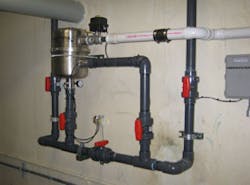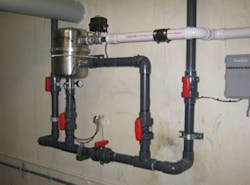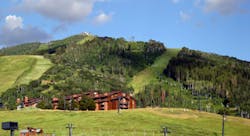City Utilizes Self-Cleaning Filters to Reduce Solids in Non-Potable Water
The Wastewater Treatment Plant (WWTP) of the City of Steamboat Springs, Colo., needed a solution to reduce solids in its non-potable water (NPW). The plant's superintendent of over 20 years, Gilbert Anderson, explained that in Steamboat Springs, treated effluent from a secondary WWTP is stored in an open pond and is then used for plant water, or NPW.
"Previously, solenoids that control water flow for washwater on the bar screen would become inoperable due to solids in the NPW," said Anderson. Likewise, the filters the facility had added to keep solids out of the solenoids required frequent filter replacement and were costing it money and excessive labor.
As such, the facility sought a way to improve NPW quality that was reliable, cost-effective and required a minimum amount of labor. After some research, it decided to try a Forsta Self-Cleaning Filter from Forsta Filters Inc. Anderson said, "We now utilize a Forsta A2-90 model filter to enhance the quality of the NPW for use as washwater on a bar screen. The system has been in service for several years with no solenoid failures and almost no maintenance -- problem solved." The A2-90 model filter offers 1 square foot of screen area, uses a 1-inch flush valve, has a cleaning duration of approximately 6 seconds, and requires roughly 4 gallons of water per cleaning cycle.
The quality of the NPW entering the Forsta Self-Cleaning Filter at Steamboat is variable due to solids such as duck weed, algae, etc., (various fauna and flora blooms) that originate in the open pond. In light of this, the filter came equipped with a stainless steel, 100-micron screen. The filtration degree was selected to be tight enough to prevent the passage of particles that were clogging the solenoids and coarse enough to easily withstand the fluctuations in solid concentration of the NPW at the inlet.
Conclusion
The city of Steamboat Springs is an excellent example of the ability of Forsta Self-Cleaning Filters to ensure the quality of NPW in WWTP applications. The automatic nature of the cleaning cycle (which does not interrupt a main system's flow) makes the Forsta Self-Cleaning Filter an ideal choice for WWTPs seeking to eliminate downtime and excessive labor. The reliability of the filtration mechanism to capture unwanted particles during normal operation coupled with the highly-efficient and automated cleaning cycle further corroborate the case for these filters in WWTPs.
Forsta Filters is an exhibitor at WEFTEC.14 and can be found at Booth 8103. For more information, visit www.forstafilters.com.


